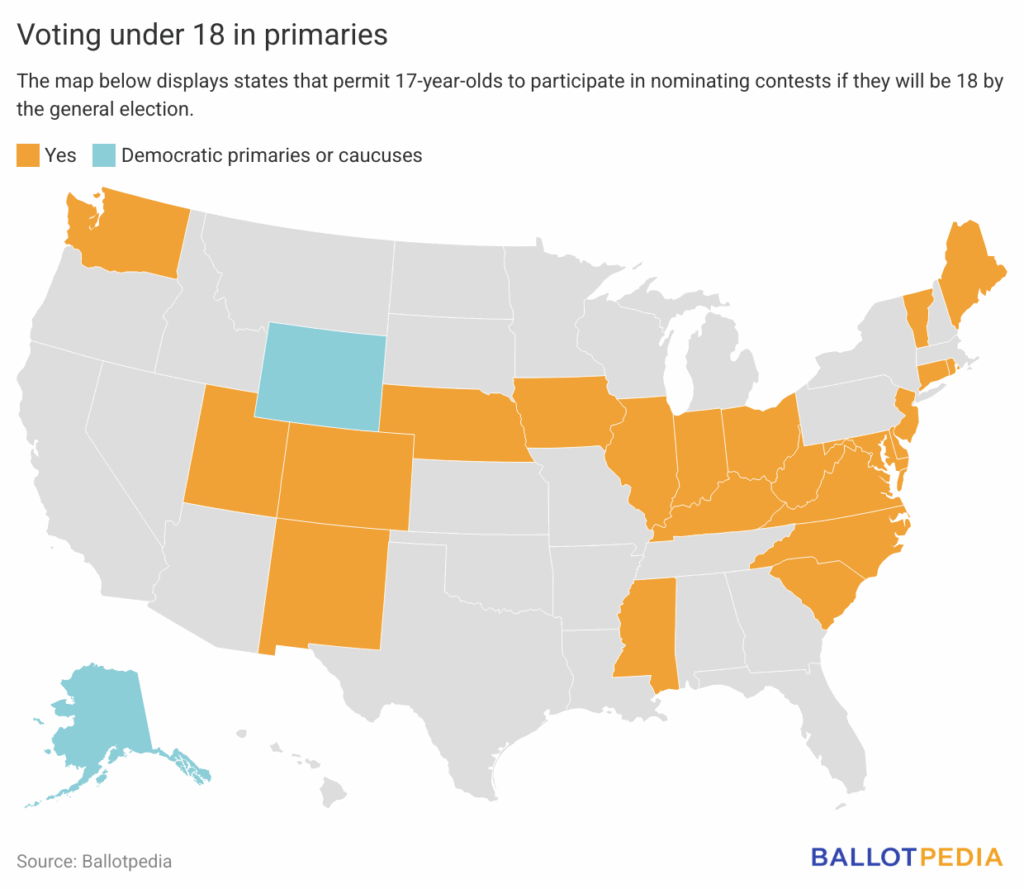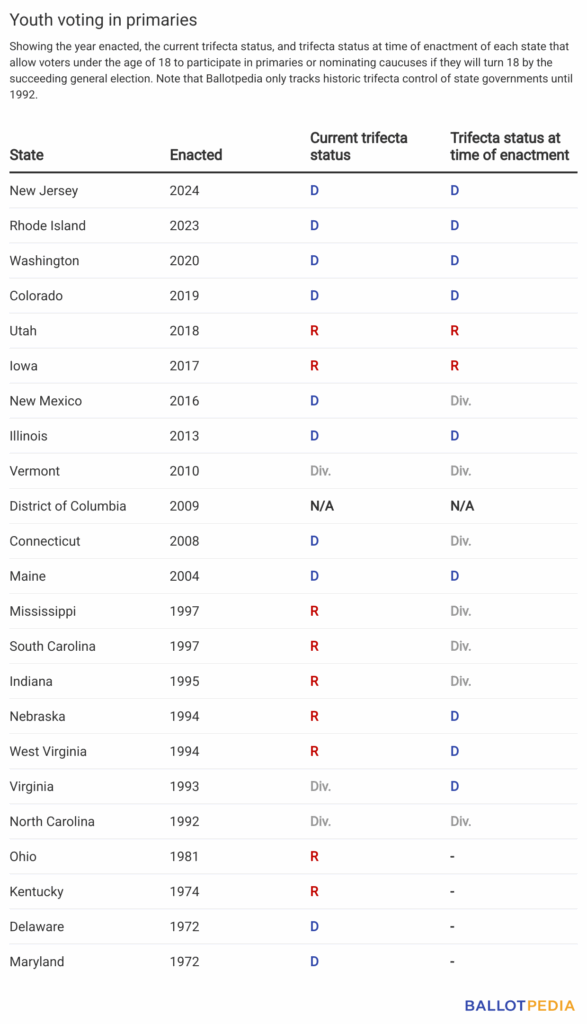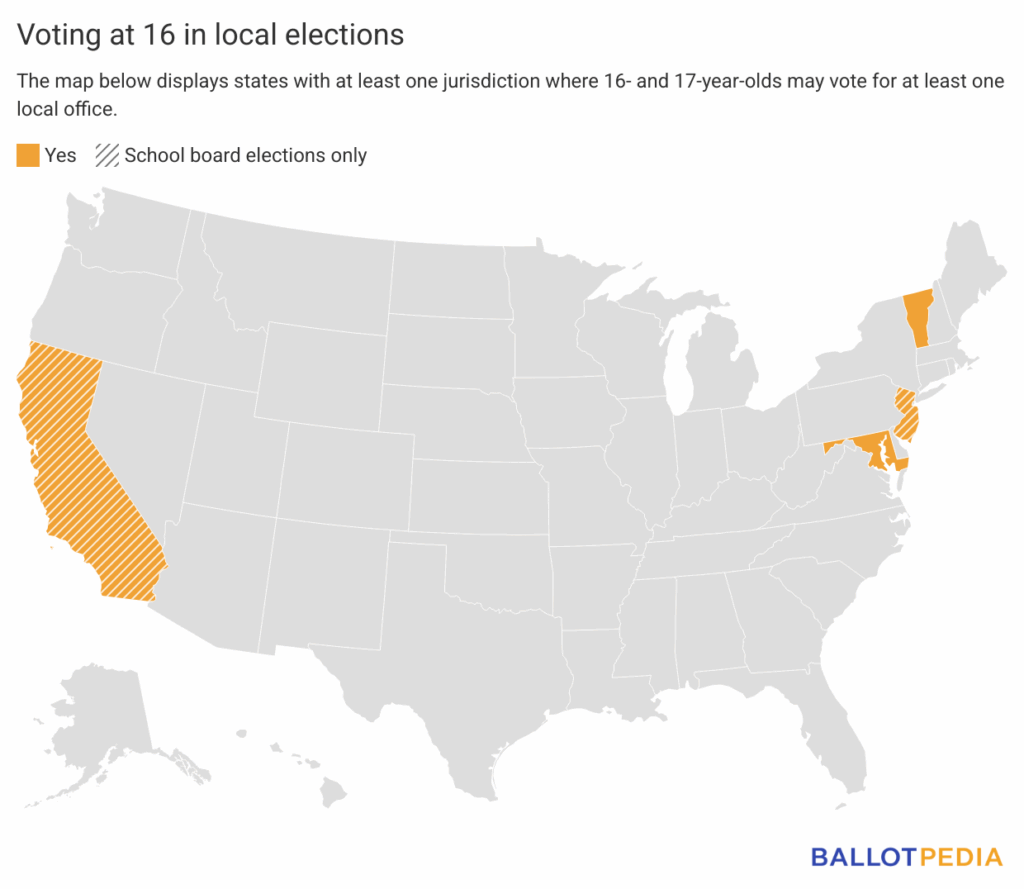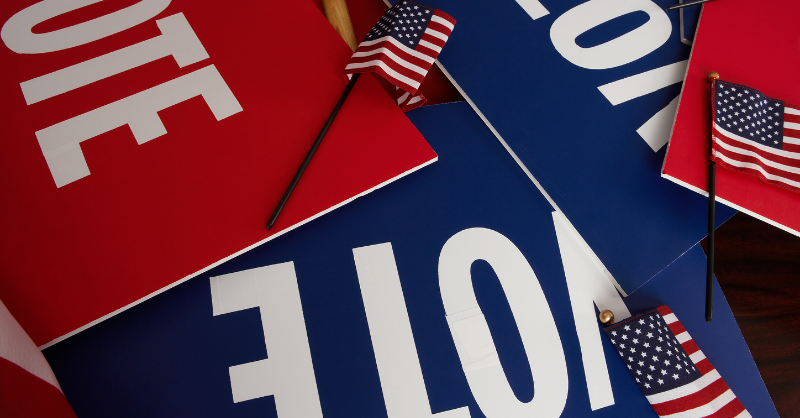On Sept. 30, 2025, the College Park City Council in Maryland voted to lower the minimum voting age in city elections to 16 years old. The change puts them among a small group of jurisdictions that allow 16-year-olds to participate in local elections. So what does youth voting look like nationwide?
In 27 states and D.C., voters under the age of 18 can vote in at least some elections. This includes two types of voters:
- Voters permitted to vote in a primary, or participate in a nominating contest, who will be 18 by the date of the subsequent general election, and
- Voters authorized by specific jurisdictions to vote in some or all local elections.
No state permits voters under the age of 18 to vote in state or federal general elections.
Primaries and nominating contests
In 22 states and D.C., laws permit individuals under the age of 18 to vote in a primary or participate in a party nominating contest if they will turn 18 by the time of the general election. In Alaska and Wyoming, the state Democratic Party permits these voters to participate in primaries, but the Republican Party does not.

In 1972, Delaware and Maryland became the first states to allow voters under 18 to participate in primaries. Nine more states joined them by 2000, and another 11 did so between 2001 and 2024.
Although there is no clear partisan breakdown among these states that have these laws — 10 have a Democratic trifecta, nine have a Republican trifecta, and three have a divided government — recent history shows that allowing 17-year-olds to participate in primaries has been a higher priority in Democratic states. The four most recent states to allow younger participants had a Democratic trifecta, and only two states with a Republican trifecta have done so since 1992.

Local elections
In four states — California, Maryland, New Jersey, and Vermont — there is at least one jurisdiction that allows 16- and 17-year-olds to vote in some or all of its local elections. Takoma Park, Maryland, became the first jurisdiction to do so in 2013.

There are currently 12 jurisdictions with a minimum voting age of 16, eight of which are in Maryland. Two more jurisdictions — College Park, Maryland, and Albany, California — have approved giving 16- and 17-year-olds the right to vote in local elections, but have not implemented the change.
In November 2024, voters in Albany, California, became the first in the country to approve a charter amendment allowing 16-year-olds to vote in all local elections. They approved Measure V 64% to 36%.
In three of the 12 jurisdictions that currently have youth voting — Berkeley and Oakland, California, and Newark, New Jersey — 16-year-olds are only allowed to vote in school board elections. In Berkeley, voters approved the change 70% to 30% through Measure Y1 in 2016. In Oakland, voters followed suit and approved Measure QQ 68% to 32% in 2020. Sixteen- and 17-year-olds first voted in Berkeley and Oakland school elections in November 2024 when roughly one-third of approximately 1,500 registered youth voters turned out, according to KQED.
The Newark, New Jersey, city council unanimously voted to allow 16- and 17-year-olds to vote in school elections in January 2024. According to Chalkbeat, 73 of 1,851 registered teens voted when the policy went into effect for the April 2025 school board election.
Vermont Gov. Phil Scott (R) sought to prevent the introduction of local youth voting in that state. The town of Brattleboro’s voters approved a charter amendment in 2019 to allow younger voters in municipal elections, which then required approval from the legislature and governor. After clearing the legislature in 2023, Scott vetoed the change, but the Democratic-led legislature overrode his veto.
The future of youth voting
With slow but consistent adoption since 1972, it is likely that more states will join those permitting voters who will be 18 for a general election to participate in the preceding primaries. Recent history shows that such laws are more likely to be enacted in Democratic-led states.
In 2025, one bill has advanced which would expand 17-year-old primary voting, New York’s S 3231. New York is a Democratic trifecta. The legislation passed the state’s Senate 41-18 on June 11, with all Democrats and three Republicans voting for it.
Despite the recent trends, some Republican lawmakers are interested in the idea. In at least two states, Massachusetts and Minnesota, Republican legislators introduced bills this year that would have brought younger primary voting to their states.
The expansion of 16- and 17-year-olds voting in local elections is more uncertain. The implementation of this policy has a shorter history, dating back 12 years, and adoption to date has been limited to a small group of states. Every jurisdiction that has approved some form of local youth voting is within a congressional district represented by a Democrat.
In several of the jurisdictions that have implemented youth voting, turnout has lagged expectations — although supporters say there will be an adjustment period and that turnout is likely to rise among the demographic in the future. There are also challenges to implementation, mostly related to voter registration and ensuring these voters receive the correct ballot when voting. To read more on this issue, click here.


